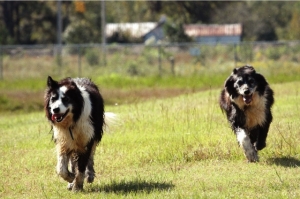Bird-er patrol helps to protect air base's jet fleet
By Kenneth Fine
Published in News on October 21, 2011 1:46 PM

News-Argus/MICHAEL BETTS
Border collies Topsie and Molly wait in a city-owned vehicle before being released into Goldsboro's Constructed Wetlands. While wandering the grounds, the dogs' daily charge is to chase away birds that look to nest there.

News-Argus/MICHAEL BETTS
Topsie and Molly patrol the Constructed Wetlands for ducks and geese -- birds that pose the biggest threat both to the nitrogen levels in the city's treated wastewater and the F-15E Strike Eagles that take flight from Seymour Johnson Air Force Base.

News-Argus/MICHAEL BETTS
Goldsboro Public Utilities Director Karen Brashear talks about just why the Constructed Wetlands and storm water retention ponds located near the Seymour Johnson Air Force Base flight line are necessary.
Molly and Topsie bided their time -- allowing a flock of ducks and geese to land, uninterrupted, on one of a handful of ponds located within Goldsboro's Constructed Wetlands.
But as soon as the birds came into view, the mother and daughter -- with eyes wide open, ears perked and tongues hanging out of their mouths -- poked their heads out of a car window and looked to one of their handlers for permission to give chase.
"Not yet," said Karen Brashear, the director of the city's Public Utilities Department. "Look at them. They're saying, 'We want to go to work.'"
And when, moments later, she opened that door, the border collies didn't waste any time.
At first they put their noses to the ground -- searching for the scent that would put them on the trail of those waterfowl they have been trained to harass.
But within a few minutes, they had already made it half way across the 40-acre site they are charged with patrolling.
To the dogs, stirring birds out of the thick patches of vegetation that line the ponds within the wetlands is a game.
They have no idea just how important their work is -- that they are saving millions of dollars and, potentially, lives, with each duck or goose they encourage to relocate.
When Gov. Bev Perdue came to Wayne County last month for a discussion with local leaders about issues that might jeopardize Seymour Johnson Air Force Base's future, several problems were identified -- encroachment, aging facilities and the state of inner-city schools.
But perhaps the most costly threat, base officials and military advocates agreed, is bird strikes.
4th Fighter Wing Operations Group Commander Col. Brian Kirkwood told the governor how the wetlands and the city's storm water retention ponds are harboring birds that are, at times, damaging the base's fleet of F-15Es.
"Our biggest safety concern centers around birds," he said at the conference.
And Military Affairs Committee member Jimmie Edmundson referenced a particularly costly incident -- and requested increased funding to focus on "bird harassment efforts" in light of it.
"On Aug. 2, 2010, we had a bird strike an F-15," he said then. "As of today, that F-15 has not been returned to service and the cost of repairs, to date, is (more than) $10 million."
Mrs. Brashear acknowledged Thursday that large birds can create problems for fighter jets and the crews that make them fly.
But she also talked about just why the Constructed Wetlands and storm water retention ponds in question are so critical -- and the steps the city, in partnership with Seymour Johnson officials, is taking to help mitigate the problem.
STORM WATER RETENTION PONDS MUST EXIST
In a region that draws heavy rain fall -- and the occasional hurricane and tropical storm -- even with a state-of-the-art sewage system -- Goldsboro's is not -- storm water retention ponds, known more formally as equalization basins, would have to exist.
"What happens is, especially after really large storm events ... the creeks fill up and the manholes that are near ditched areas get water over the top of them," Mrs. Brashear said. "Water can leak inside those manholes, and when that happens, we get a lot more storm water coming into the plant.
"Well, we're not supposed to be treating that much flow and we don't want to hydraulically overload the Waste Water Treatment Plant. We don't want to not treat the waste correctly."
So a computerized gate that recognizes when the plant has reached capacity only allows as much flow as it can handle.
The rest is directed toward the equalization basins.
Some have suggested that Goldsboro simply lobby the state and federal governments for funding for a massive expansion at the plant.
That way, they say, more flow could be handled and the bird threat coming off the retention ponds would seize to exist.
Mrs. Brashear, though, has several problems with that idea.
"That's not really a solution. You can't just build bigger and bigger concrete basins because ours is a biologically balanced plant," she said. "We wouldn't have enough food to feed those microorganisms."
And no matter how much money you throw at infrastructure repair -- the city has already invested millions doing work on the older lines and manholes that might allow leaking to occur to reduce the amount of flow to the basins -- big rain will always create overflow.
"In large storm events, you're never going to be able to stop every bit from coming in," Mrs. Brashear said. "You just can't."
CONSTRUCTED WETLANDS FURTHER PROTECT NEUSE RIVER
When the city invested more than $3 million to create the Constructed Wetlands Seymour Johnson officials have said are harboring birds that are, at times, damaging the base's fleet of Strike Eagles, it did so to reduce Goldsboro's environmental impact on the Neuse River.
"Do you see the water coming in over there?" Mrs. Brashear said, pointing to a structure located in the middle of one of the ponds scattered across the 40-acre site. "It has already been disinfected with ultraviolet light and chlorine."
But the water, which has already, by the time it reaches the wetlands, gone through the Waste Water Treatment Plant, still contains nitrogen.
"So before it goes back into the river, it goes through the 40 acres of constructed wetlands," Mrs. Brashear said. "We want more of the nitrogen polished out."
Untreated waste water contains, on average, roughly 14 mg of nitrogen per liter.
And by the time it leaves Goldsboro's plant, that number has been reduced to 3.5.
But Mrs. Brashear said, particularly given the "delicate" ecosystem downstream, more treatment through the wetlands makes sense.
"When the water leaves here, it's at about 1 mg/liter," she said. "And that's what we want. We want to eliminate as much of the contribution from our citizens from the Neuse River as possible for downstream users and aquatic life."
BIRD HARASSMENT IS ONLY VIABLE SOLUTION TO BASE'S PROBLEM
The city believes that through its current partnership with agencies on Seymour Johnson, they are helping to mitigate bird strike woes.
If Mrs. Brashear or members of her staff see large flocks of waterfowl, they contact the base.
"We call them and they'll come and investigate," she said. "If they need to, they'll shoot off their pyrotechnics to scare them away. So we really do partner."
And wires have been placed across the equalization basins to disrupt geese and ducks -- interrupting their swim, Mrs. Brasher said, deters them from coming back.
But the two beings making the biggest impact on the bird population have no idea what an F-15E is.
They couldn't tell an Air Force uniform from a pair of blue jeans.
And they certainly don't understand just why the bodies of water they are charged with patroling are necessary to the waste water treatment process.
But Molly and Topsie do know how to catch the scent of a goose or duck.
They can hear a female bird building a nest.
And most importantly, by simply sticking out their tongues and scooting along -- and within -- the vegetation that lines those ponds, they are saving millions of dollars in fighter jets repairs -- and, potentially, lives.
Even if to them, it's all just a game.
"Their job is to keep the females flushed out so they don't nest. We don't want them raising young here because then the young get imprinted on this area," Mrs Brashear said, looking across the grounds as Molly and Topsie lose themselves along one of the banks. "And they love their job. I mean, just look at them. Give them some dry dog food and they're happy."
